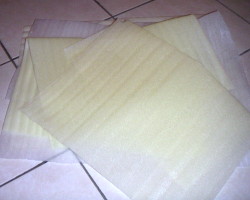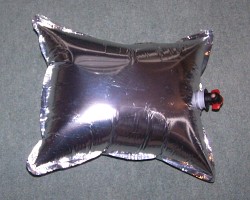How can I reuse or recycle liquid-filled cold packs?
We’ve had an email from Ann:
Hello – we regularly receive medications shipped to us in a foam cooler, packed in plastic-wrapped foam cold packs (with some sort of liquid embedded). It’s easy to recycle the little cooler at the recycling center, but I wonder about the cold packs, since they contain the liquid. I hate to send them to the landfill. Any suggestions? Thanks.
I can’t find any pictures illustrating what Ann means but she assures me they’re “they’re liquid filled packs with a spongey, foam material inside too”.
If they’re suitable, I’d be tempted to keep one or two coolers and cold packs for using on picnics or the like – but that’s only one or two and by the sounds of it, Ann needs a more long-term solution.
So any ideas?
UPDATE: Ann’s sent me a link to the packs on the manufacturer’s website and said she’s going to contact them to see what they suggest – and hopefully she’ll feedback to us if she hears anything :)
























If they are what I think they are, I believe they can be reused in cavity wall insulation.
With a veggie box scheme we get they have some of those cold packs etc and they reuse them until they are a bit too past it then have them recycled into wall insulation.
I am assuming there will be some company out there who would take them to do this.
If they are like the reusable medical cold packs, then they could be donated to nursery schools, etc. for children.
I suggest this because numerous times my 5 year old niece will bump herself. She doesn’t need the cold pack, but it makes her feel better and doesn’t deplete the supply of bandages in the house.
Why not send them back to the manufacturer who sent them to you? (include a note for them to recycle/reuse) Let them re-use them on future orders. It would be nice if they setup a free return shipping label (like ink cartridges now) for recycling/reuse. Otherwise, have you tried FREECYCLE? I’m sure people in sports could use them.
I’m not acquainted with FREECYCLE. For now, I have contacted the manufacurer for advice as to the suitability of recycling. I like the wall insulation idea, but our house is 100 years old and its walls are not hollow. I had another idea similar to one above, to contribute to the school nurses in our area. Two members of my church are school nurses and I know they encounter lots of bumps and bruises. Ann
Great idea. If they would pay shipping and handling.
sodium acrylamide is the component used in freezer gel packs and Blue Apron is the only company that has a “take back” program but is highly not likely to reuse them as they can easily be contaminated by juice from fish or other meat in shipping and the cost to sterilize them is prohibitive.
cost to ship back would also not make any sense and likely the packs are sent to landfill.
The soil amendment often sold to retain moisture in the soil is polyacrylamide (PAM) hydrogels: soluble (linear) and insoluble (cross-linked) and I’m not sure how similar they are. Someone needs to look into this recycling option to see if there is any positive result to just mixing into your potting mix or compost pile without any negative effect.
For more info on freecycle, visit: http://www.freecycle.org – It’s a global grassroots and entirely nonprofit movement of people who are giving (& getting) stuff for free in their own towns. It’s all about reuse and keeping good stuff out of landfills. Rita
keep it cold to use on booboos
I work for a pediatrician, and we get these, too. Or something similar. I keep one in the fridge at home. It is great to use for a headache! (I find they freeze too solidly, so I only refrigerate them.)
Depending on size but I have a camelbak and put a couple of long thin lollipops inside them. Could these be an effective substitute? What is the liquid?
Looks as if they would make great colpaks for those that hang on you like a bak back while your doing work in the heat.
They could be frozen and donated at each hunting season for hunters to pack their meat with after their kill. Contact the sporting goods stores and make an inexpensive flyer as to where they can get them.
It is possible that your local meals on wheels could use both the cold pacs and the containers they come in to deliver meals that need to be kept cool.
Open them up and mix the contents into potting soil. They will absorb the water and give the plant longer access to it.
I don’t get it. What is with you people who want to dump out the contents into the environment?
Have you any idea if there is a petroleum or other chemical component s?
some of these cold packs contain ammonium nitrate which if the
bag breaks could be very dangerous. As you may be aware. ammonium
nitrate is made with ammonia and nitric acid both are very corrosive
you cannot inhale the fumes if heated get it on your clothes ,ingest it
even get it on your skin. you must use large amouts of water to
neutralize it. As far as donating these items to anywhere but a hazmat
dump would be a big mistake.
For Donald Doyle: that is ammonium chloride. Ammonium nitrate is simply chicken poop, which is also used as a natural fertilizer.
Your confusing the discussion. These are not the instant cold packs you shake after breaking a plastic vial inside the ammonium nitrate for instant cooling. We’re talking about the gell pack that you freeze in the freezer to help keep your picnic foods cool throughout your trip. The gell can be refrozen again and again till the bag gets a hole. Blue Apron and many of the other delivery food services are shipping up to 15 lbs of these gell packs per order so that your meat doesn’t spoil throughout shipment. TAs the gel packs pile up week after week you’ll have more gel packs than you can use in a lifetime of outings or picnics.
Think where does petroleum come from, the ground so why would this be harmful, ammonia is urine, I use it to keep critters away from my garden, especially deer.
Give them to friends who camp, to use instead of coolpacks?
We do not have an excess of these packs, but so far we have just enough of them to line the bottom and sides of our freezer. I have placed them there because they help keep the temperature more consistent during all the daily ins and outs, and if the power goes out the food has a better chance of surviving in frozen form, especially if we do not open the freezer door. The packs act in the freezer just like they would act in a cooler, when the power goes out.
Disposable Nappies!
Did you know that the new disposable nappies are full of ‘swell gel’, it’s the same stuff you get from the garden centre to add to compost to retain moisture and costs around £5 a box.
I have started to re-use my grandson’s nappies, just the wet ones! Rinse them in the shower until all the ‘yellow’ has gone and they don’t smell. Rip one end and squeeze them into your compost and hay presto compost that doesn’t dry out. Ideal if you live in an area that has hose pipe bans every summer. I’m always nagging my daughter about the nappies; I always used towelling ones. And the thought of all the nappies ending up in landfill horrifies me.
Have a go, it’s free and greener.
Katie, A new nanny
I just found information about recycling both the cool packs and the styrofoam shippers. This only applies to the specific brand I get, but maybe the other providers also supply this kind of information for their products.
http://www.coldchaintech.com/recycling/
I work for a pediatric clinic and we throw away dozens of these packs a week as well as heavy, thick insulated boxes in which vaccinations are shipped. The companies don’t generally want them back because shipping cost are prohibitive. These things are expensive and there just has to be a way that they can be used again. We have way too many for staff to use them at home and I dont’ know about daycares and schools because they do contain an unknown that could be released (and consumed) if punctured.
The commercial refrigerant gels in the gel packs vary on primary substance. They are commercial grade as they stay too cold too long to safely use on human bodies. Hence, too, homemade gel packs maybe unwise to use for an overextended time and in direct use as to cause frostbite. Commercial products are non-toxic but still can prove hazardous to your health if used improperly. If made with a cellulose ether/polymer, then the product when dried out will be a fine dust that can prove to be explosive when mixed with air (as silo dust from stored grains can be). When spilled and still wet, the mixture is very slippery, like an icy surface. As the items are composed of non-toxic materials, disposal (of the gel) is best in a water sewage treatment system with the plastic bag tossed in a recycling container. Most gel bags have safety notices stamped on the bag. Other information can be found on mfgr MSDS (material safety data sheet).
Don’t you know that Ammonium nitrate is a very common ingredient in fertilizer and is a very good source of nitrogen. What’s with this “dangerous” stuff. As long as you don’t drink it! It is very soluble in water and does not take much water to neutralize. Where do you people get your info??
If Steve Young (posted Jan 18, 2011) reads this, please could he just say whether he thinks that French ‘frizets’ (I have 8 !), which can be/were used in cool-boxes when camping, contain ammonium nitrate? If so, would it be safe for me to empty the liquid down the sink? (The plastic containers can now be recycled, I am told.)
@ Steve: The reason why we think this stuff is “dangerous” is because it’s written on the package that if it comes into contact with the skin to wash immediatly with plenty of water and if it is ingested to drink lots of water and call an anti-poison centre right away. That is reason enough to presume that it is dangerous for the environment.
As for the disposal of these packs, sometimes there is more than ammonium nitrate in them, so dissolving the liquid in water and pooring it on the lawn is probably not the best idea in the world.
These should be handled like hazardous material and be disposed of at a hazardous material complex. You could also communicate with the company that produces these packs and ask what to do with them after use. Cheers.
No, they are not hazardous, but putting anything on your skin not approved by he FDA for application to skin requires such a warning. Contact the manufacturer for info about what is inside. (Or google MSDS and the product name.) Cold Chain brand packs, for example, contain Carboxy-Methyl-Cellulose, which is harmless. Nonetheless, I don’t drink or slather same on myself. If the bag is broken, wash it down the drain and throw out the package.
I too receive cold packs with medication on a regular basis. Looking for a recycling solution I found this web site and I visited the manufacturers site. Mine are called Koolit and are manufactured by Cold Chain Technologies. They say the product is an environmentally safe starch and can be disposed of ‘down the drain’ so to speak. So at least they are not toxic. It still does not help with the reusable issue. I guess I will just put them up on freecycle.
I’ve got the same problem. eHOW said to cut them open, drain the gel into a bucket to dump on your lawn, recycle the bag. The warning posted above is for the “old style” freezer packs. I don’t think it’s applicable with anything received now. Also, they’re great for filling up unused areas in your freezer [they can be refrozen] which makes the freezer run more efficiently.
I want to know if this can be used as fertilizer but can find no definite answer.
Thank you.
I put on parties… & need to keep dishes of food cold on table.
I cut a bag of this gel open, spread it out on cookie sheet & ‘lightly’ pressed bowls into gel & refroze. Then can set food (in bowls in the imprints)-keeps food cold for quite some time.
IS THIS TOXIC-if gel is covered over with film paper b4 food dishes are set on it?
Tina says:
April 24, 2017 at 8:47 pm
I put on parties… & need to keep dishes of food cold on table.
I cut a bag of this gel open, spread it out on cookie sheet & ‘lightly’ pressed bowls into gel & refroze. Then can set food (in bowls in the imprints)-keeps food cold for quite some time.
IS THIS TOXIC-if gel is covered over with film paper b4 food dishes are set on it?
I have an injection which is now being delivered using cool packs. There are no markings on the packs so I contacted the supplier, Pharmaxo of Corsham, Wiltshire, re disposal of the cool packs and I was assured there was no problem in just putting them in the bin.
one problem that people don’t think of when disposing of them in the trash. When the gel dries up (and this will eventually happen) it can turn into a powder which is not good.
Your confusing the discussion. These are not the instant cold packs you shake after breaking a plastic vial inside the ammonium nitrate for instant cooling.
We’re talking about the gel pack that you freeze in the freezer to help keep your picnic foods cool throughout your trip. sodium acrylamide The gel can be refrozen again and again till the bag gets a hole. Blue Apron and many of the other delivery food services are shipping up to 15 lbs of these gell packs per order so that your meat doesn’t spoil throughout shipment. TAs the gel packs pile up week after week you’ll have more gel packs than you can use in a lifetime of outings or picnics. Nordic Ice sells millions of tons for food, medical, and aquarium transport globally. The gel in these is not exactly the same as the moisture absorbing gel in diapers or used to amend the soil. polyacrylamide (PAM) hydrogels: soluble (linear) and insoluble (cross-linked).
Amazon Now grocery delivery in the US is now using cool packs. I simply looked up the manufacturer (ProPak). Their website says these particular cold packs are composed of water, small amounts of cellulose gum and salt. They are “environmentally safe and can be thrown away.”
I too receive food baskets with refrigerated gel packs. FYI. SUNBASKET uses cool gel packs that have only water and cotton (even non-GMO) so their gel is fully compostable and I am tempted to switch to them. I also suggest asking your service (for whatever you are getting numerous gel packs) to investigate the ones with cotton (there is no name provided through SunBasket). But as stated above, I am referring to the soft gel freezer packs. Blue Apron (food basket) and the Nordic ice people say to dispose of gel in the waste basket (landfill). I have written to them to ask if it is compostable (thinking also of the diaper gels and other water retaining gels). This is NOT the same as the diaper gel, and I still don’t have information on whether it is harmful to plants or animals (thinking in compost, don’t want something with high salts or other things that might be bad in food as well as critters like lizards). The response was to was again to dispose of in the trash, so I am assuming it is not good for plants. Thank you to whoever put the actual chemical name above so I can research more.
Leila,
Most likely the reason the manufacturer is responding that way is because that is what their attorney recommended, to avoid any remote possibility of them being sued. I am pretty sure that the ingredient in the ones we get, made by Pelton-Shepard Industries, is a polymer. Before I retired from the landscaping industry, I used a product called a soil polymer which was I used when laying sod or planting grass seed. It retains water, decreasing the frequency of the need to water. You can check it out at……….http://www.soilmoist.com/products/landscapers.php